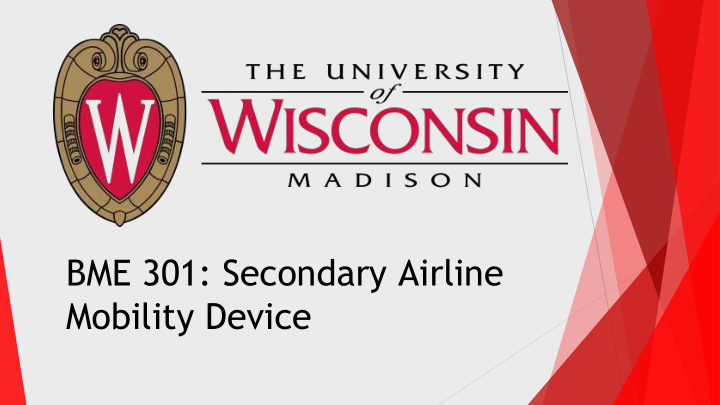



BME 301: Secondary Airline Mobility Device
Secondary Airline Mobility Device Client- Dan Dorszynski Advisor- Dr. Ed Bersu Team - Will Fox - Team Leader Grant Karlsson Ellifson - Communicator Jonathan Evans - BSAC, BPAG Desiree Flouro - BWIG
Overview ▶ Problem Statement ▶ Background ▶ Project Design Specifications ▶ Prototype ▶ Areas of Improvement ▶ Final Design ▶ Semester Plan ▶ Future Work ▶ References and Acknowledgments
Problem Statement Airline travel is extremely difficult for disabled - passengers Need to build a device to simplify the overall process - and create healthier flying environment for disabled individuals
Background Airline Travel with Wheelchair Transfer from passenger’s wheelchair to aisle ● wheelchair Transfer from aisle wheelchair to seat ● This is done in reverse when plane lands ● Associated Risks Damage to passenger’s wheelchair in cargo ● Risk of being dropped during any transfer ● Common aisle wheelchair
Product Design Specifications Design Requirements: Minimize number of transfers during boarding process (four currently) - Foldability/Stowability for when device is not in use - Proper safety belts/harnesses - Adhere to current FAA and U.S Access Board Guidelines for Aircraft Boarding - Chairs
Prototype Final Design Benefits - - Minimal risk of dropping Simple fabrication and use - - Easy to explain process Concerns - - Weight bearing properties Stowability -
Prototype Pros: ● Able to support 305 pound load ● Maneuverable ● Met current FAA restrictions Cons: ● Heavy ● Weak at connections on frame ● Cumbersome locking mechanism ● Lacked safety features Our prototype on Mr. ● Not stowable in flight Dorszynski’s wheelchair
Areas of Improvement ● Improve stowability ● Incorporate locking hinges ● Strengthen frame ● Reduce unnecessary weight ● Add in seat belt ● Modify seat cushion material [3] Image of MIG welding
Final Design Similar to SolidWorks image ▶ ▶ With added features ▶ Will be added to SolidWorks for testing
Locking Mechanism
Hinges Will lock in place at 90 degrees. ▶ ▶ Can fold to be flat for maximum stowability. ▶ Several different hinges are available ▶ These can hold 330 pounds maximum ▶ Weight distribution ▶ Aids with carrying capacity
New Seat ▶ Will be made like a weight bench. ▶ Stiffer Material ▶ Slick Surface ▶ Optimum thickness is 8 cm.
Safety Features ▶ One lap belt ▶ Prevents fall risk ▶ Footrests on the front legs ▶ Prevents feet from contacting ground
Project Schedule Week 7: Finalize material choices and construct fabrication plan ▶ ▶ Week 8-9: Fabrication ▶ Week 11: Complete fabrication and begin testing ▶ Week 12: Testing ▶ Week 13: Finalize testing, begin work on final deliverables ▶ Week 14: Present final design
Future Work Obtain ambulance stretcher for leg analysis and mechanism ▶ incorporation into back legs Research potential for mass production, feasibility ▶ Mock run-through of use in airport setting ▶
References and Acknowledgements We would like to thank the following individuals their assistance thus far: Dr. Ed Bersu Dan Dorszynski (1) Rita.dot.gov. (2017). Data Analysis | Bureau of Transportation Statistics. [online] (2) Wholesale Marine. (2018). Garelick Stainless Steel Seat Support Swing Leg - 28.25". [online] Available at: https://www.wholesalemarine.com/garelick-stainless-steel-seat-support-swing-leg-28-25.ht ml?gclid=EAIaIQobChMIl5Wfk-u12QIVG7XACh0oywKFEAQYASABEgJZE_D_BwE [Accessed 22 Feb. 2018]. (3) Briscoe, J. (2018). Average Welder Salary 2018 - How Much Do Welders Make - The Gazette Review . [online] The Gazette Review. Available at: https://gazettereview.com/2017/03/average-welder-salary-much-welders-make/ [Accessed 27 Feb. 2018].
Questions?
Recommend
More recommend